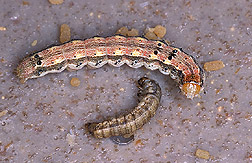This page has been archived and is being provided for reference purposes only. The page is no longer being updated, and therefore, links on the page may be invalid.
|
Read the magazine story to find out more. |
Controlling Crop Pests With BaculovirusesBy David ElsteinJanuary 17, 2002 Bollworm and budworm pests attack more than 30 food and fiber crops around the world, causing annual damage and control costs of more than $1.25 billion in the United States alone. As a new way to control these pests, Agricultural Research Service scientists are studying organisms called baculoviruses. These are rod-shaped DNA viruses, many of which begin their life cycles reproducing inside cells. Caterpillars infected with baculoviruses die but remain on the surfaces of leaves, where healthy caterpillars take in the virus and a new cycle begins. This cycle occurs naturally, but ARS researchers are designing baculoviruses to kill pests. While baculoviruses take longer to work on target pests, they kill specific insects, unlike chemical insecticides that sometimes kill beneficial ones. Another problem, which researchers are working on, is finding a way to help the baculoviruses survive in sunlight, since they are inactivated by ultraviolet-B (UV-B) rays. Entomologists Cynthia L. Goodman, James J. Grasela and Carlo M. Ignoffo (retired), along with microbiologist Arthur H. McIntosh, are trying to find solutions to these problems. All are with the Biological Control of Insects Research Laboratory in Columbia, Mo. Several companies are trying to mass-produce baculoviruses, since the organisms may eventually be used instead of insecticides because they are safer for the environment. Scientists are trying to produce the viruses in insect cells rather than in the whole insect-- to save money and keep them free of contaminants. The insect cell cultures have many uses, besides just being used as a vehicle for growing baculoviruses. They are also used to perform research on how well baculoviruses can be used as a pesticide. The cultures may also help scientists find out why certain chemicals kill or paralyze a particular insect. Additionally, researchers are using insect cell cultures to produce proteins important as drugs or as diagnostic tools for medical purposes. For more detailed story, see January’s issue of Agricultural Research magazine. ARS is the U.S. Department of Agriculture’s chief scientific research agency. |

